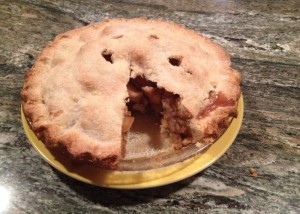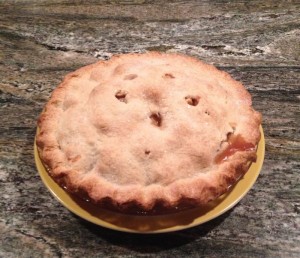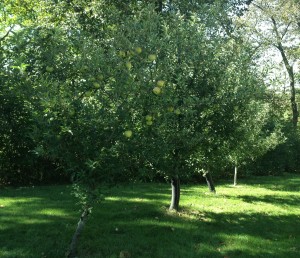One taste of the apples from Dad’s trees and Deb O’s kind delivery of freshly picked Fugi apples were inspiration enough to get out the pastry board and rolling pin. Pie baking time is here!
Years back, our dad propagated an apple tree that produced delectable pie apples. He named them Mac’s Goldens. Five or six years ago, Moser Fruit Tree Sales, Inc., of Coloma, Michigan, deemed the apples delicious and asked for a dozen small branches for grafting. We were the lucky recipients of five of these new Mac’s Golden trees. Moser Fruit Tree Sales, Inc., retained the rest of the trees for study and potentially for adding to their catalog.
While our dad prefers waiting until after a light frost when these apples turn golden with a pink blush, we like them a bit crunchy and tart. Combining the tart apples with sweet and softer Fugis or other similar apples makes for a pie that bakes with a bit of sweet syrup but still retains its form without baking down flat.
Apple pie recipes abound, but the recipes are often short on hints for adjusting ingredients based on texture, taste, or ripeness of apples. Ingredients that worked on apples picked last week may need to be adjusted as the apples ripen. Here are a few hints we have learned from our mom, the apple pie baking queen, and from years of experimenting:
- Most recipes suggest 6-7 apples, but we like fat pies with 8-10 apples.
- Taste a slice of the apple to help determine appropriate sugar and flour amounts to be added. While most recipes suggest 2/3 cup of sugar to be added to the apple slices, sweeter apples require slightly less sugar. I like using a combination of white and brown sugar.
- Softer apples require more flour – 3 or 4 tablespoons. Firmer apples don’t generally cook down as much and may only require 2 tablespoons of flour.
- The flavor of rather bland apples can be supplemented with a tablespoon or two of freshly squeezed lemon or orange juice.
- After adding sugar, flour, cinnamon and other desired spices, pre-cooking the apples in the microwave for 3 minutes before adding them to pie crust is beneficial. Otherwise, when the apples bake down in the pie, you might be left with a hollow dome of baked crust. Also, the apples are sufficiently baked before the crust gets over-baked.
- The pie is done when juice begins to bubble through the air vents sliced into the top pie crust.


